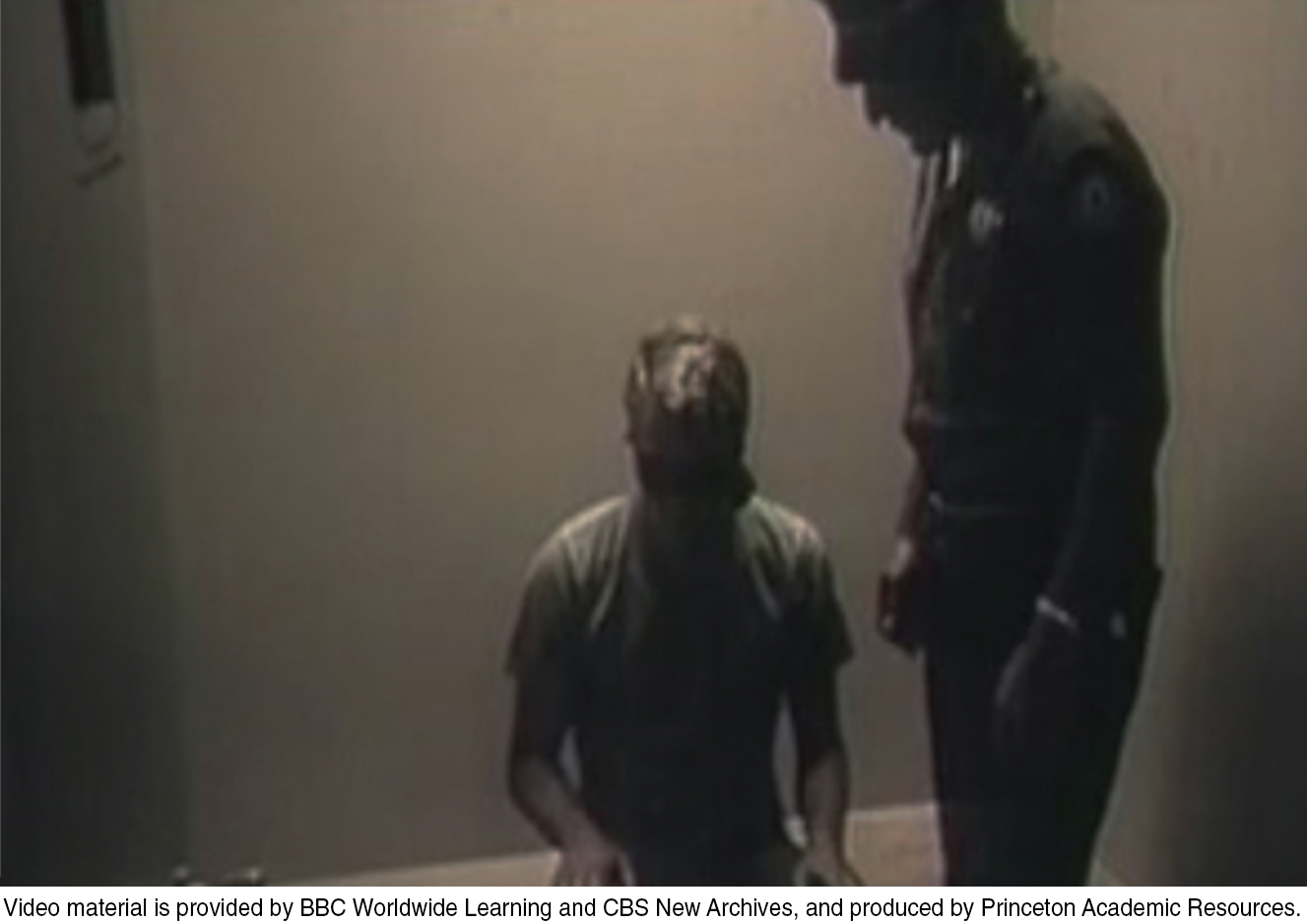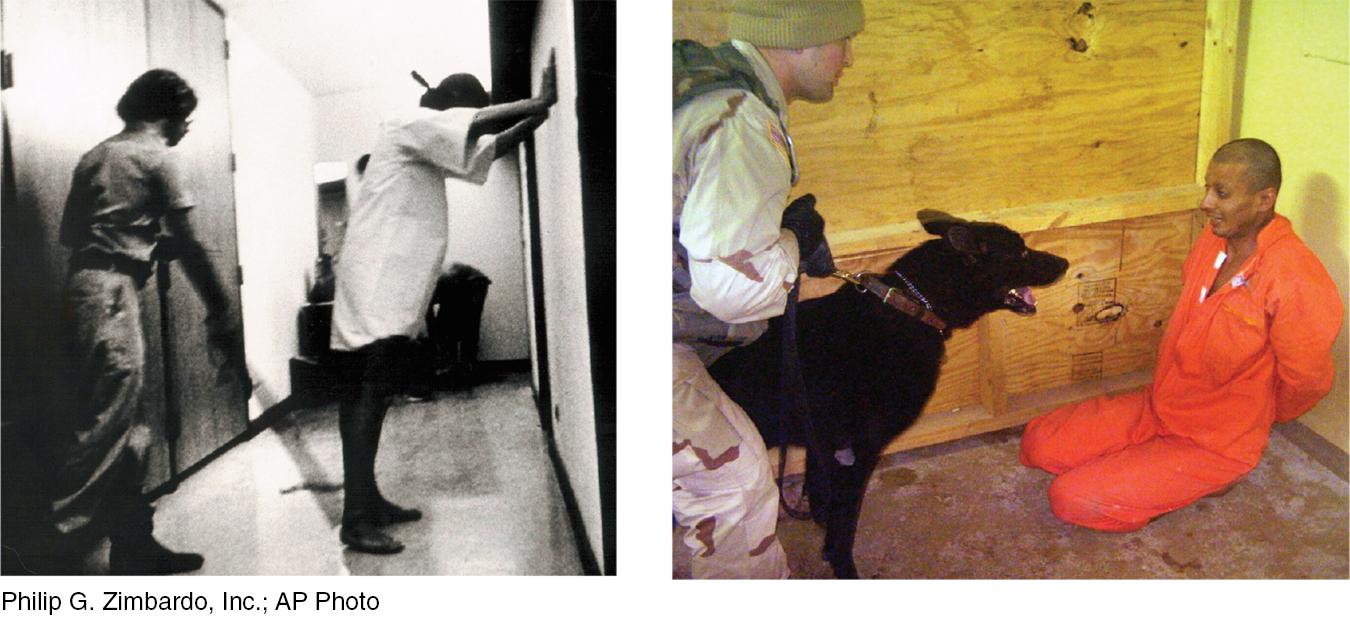35.1 Social Thinking
social psychology the scientific study of how we think about, influence, and relate to one another.
Personality psychologists focus on the person. They study the personal traits and dynamics that explain why different people may act differently in a given situation, such as the one Willems faced. (Would you have helped the jailer out of the icy water?) Social psychologists focus on the situation. They study the social influences that explain why the same person will act differently in different situations. Might the jailer have acted differently—
The Fundamental Attribution Error
attribution theory the theory that we explain someone’s behavior by crediting either the situation or the person’s disposition.

Our social behavior arises from our social thinking. Especially when the unexpected occurs, we want to understand and explain why people act as they do. After studying how people explain others’ behavior, Fritz Heider (1958) proposed an attribution theory: We can attribute the behavior to the person’s stable, enduring traits (a dispositional attribution), or we can attribute it to the situation (a situational attribution).
fundamental attribution error the tendency for observers, when analyzing others’ behavior, to underestimate the impact of the situation and to overestimate the impact of personal disposition.
For example, in class, we notice that Juliette seldom talks. Over coffee, Jack talks nonstop. That must be the sort of people they are, we decide. Juliette must be shy and Jack outgoing. Such attributions—
David Napolitan and George Goethals (1979) demonstrated the fundamental attribution error in an experiment with Williams College students. They had students talk, one at a time, with a young woman who acted either cold and critical or warm and friendly. Before the conversations, the researchers told half the students that the woman’s behavior would be spontaneous. They told the other half the truth—
Did hearing the truth affect students’ impressions of the woman? Not at all! If the woman acted friendly, both groups decided she really was a warm person. If she acted unfriendly, both decided she really was a cold person. They attributed her behavior to her personal disposition even when told that her behavior was situational—
WHAT FACTORS AFFECT OUR ATTRIBUTIONS? The fundamental attribution error appears more often in some cultures than in others. Individualist Westerners more often attribute behavior to people’s personal traits. People in East Asian cultures are somewhat more sensitive to the power of the situation (Heine & Ruby, 2010; Kitayama et al., 2009). This difference has appeared in experiments that asked people to view scenes, such as a big fish swimming. Americans focused more on the individual fish, and Japanese people more on the whole scene (Chua et al., 2005; Nisbett, 2003).
 For a quick interactive tutorial, visit LaunchPad’s Concept Practice: Making Attributions.
For a quick interactive tutorial, visit LaunchPad’s Concept Practice: Making Attributions.
We all commit the fundamental attribution error. Most of us have had the experience of meeting someone we know from a particular situation—
When we explain our own behavior, we are sensitive to how behavior changes with the situation (Idson & Mischel, 2001). (An important exception: We more often attribute our deliberate and admirable actions not to situations but to our own good reasons [Malle, 2006; Malle et al., 2007].) We also are sensitive to the power of the situation when we explain the behavior of people we know well and have seen in different contexts. We more often commit the fundamental attribution error when a stranger acts badly. Having only seen that red-
Some 7 in 10 college women report having experienced a man misattributing her friendliness as a sexual come-
As we act, our eyes look outward; we see others’ faces, not our own. If we could take the observer’s point of view, would we become more aware of our own personal style? To test this idea, researchers have filmed two people interacting with a camera behind each person. Then they showed each person a replay of their interaction—
WHAT ARE THE CONSEQUENCES OF OUR ATTRIBUTIONS? The way we explain others’ actions, attributing them to the person or the situation, can have important real-

Consider the social and economic effects of attribution. How do we explain poverty or unemployment? In Britain, India, Australia, and the United States (Furnham, 1982; Pandey et al., 1982; Wagstaff, 1982; Zucker & Weiner, 1993), political conservatives have tended to attribute responsibility to the personal dispositions of the poor and unemployed: “People generally get what they deserve. Those who take initiative can choose to get ahead.” After inviting people to reflect on the power of choice—
The point to remember: Our attributions—
Attitudes and Actions
35-
attitude feelings, often influenced by our beliefs, that predispose us to respond in a particular way to objects, people, and events.
Attitudes are feelings, often influenced by our beliefs, that predispose our reactions to objects, people, and events. If we believe someone is threatening us, we may feel fear and anger toward the person and act defensively. The traffic between our attitudes and our actions is two-
ATTITUDES AFFECT ACTIONS Consider the climate change debate. On one side are climate change activists and the Intergovernmental Panel on Climate Change (2014), who warn of accumulating greenhouse gases, melting glaciers, shrinking Arctic ice, rising seas, dying coral reefs, migrating species and vegetation, and extreme and warming weather. On the other side are climate change skeptics, who include many in the general public. The 31 percent who in 1998 thought “the seriousness of global warming is generally exaggerated” had increased to 42 percent by 2014 (Dugan, 2014).
Knowing that public attitudes affect public policies, people on both sides aim to persuade. Persuasion efforts generally take two forms:
peripheral route persuasion occurs when people are influenced by incidental cues, such as a speaker’s attractiveness.
central route persuasion occurs when interested people focus on the arguments and respond with favorable thoughts.
Peripheral route persuasion doesn’t engage systematic thinking, but does produce fast results as people respond to uninformative cues (such as celebrity endorsements) and make snap judgments. A trusted politician may declare climate change a hoax. A perfume ad may lure us with images of beautiful or famous people in love.
Central route persuasion offers evidence and arguments that aim to trigger favorable thoughts. It occurs mostly when people are naturally analytical or involved in the issue. Climate scientists marshal evidence of climate warming. An automotive ad may itemize a car’s great features.
Persuaders try to influence our behavior by changing our attitudes. But other factors, including the situation, also influence our behavior. Strong social pressures, for example, can weaken the attitude-
Attitudes are especially likely to affect behavior when external influences are minimal, and when the attitude is stable, specific to the behavior, and easily recalled (Glasman & Albarracín, 2006). One experiment used vivid, easily recalled information to persuade people that sustained tanning put them at risk for future skin cancer. One month later, 72 percent of the participants, and only 16 percent of those in a waitlist control group, had lighter skin (McClendon & Prentice-
ACTIONS AFFECT ATTITUDES Now consider a more surprising principle: Not only will people stand up for what they believe, they also will more strongly believe in what they have stood up for. Many streams of evidence confirm that attitudes follow behavior (FIGURE 35.1).

THE FOOT-
foot-
How did the Chinese captors achieve these amazing results? A key ingredient was their effective use of the foot-
In dozens of experiments, researchers have coaxed people into acting against their attitudes or violating their moral standards, with the same result: Doing becomes believing. After giving in to a request to harm an innocent victim—
“If the King destroys a man, that’s proof to the King it must have been a bad man.”
Thomas Cromwell, in Robert Bolt’s A Man for All Seasons, 1960
Fortunately, the attitudes-
Racial attitudes likewise follow behavior. In the years immediately following the introduction of school desegregation in the United States and the passage of the Civil Rights Act of 1964, White Americans expressed diminishing racial prejudice. And as Americans in different regions came to act more alike—
role a set of expectations (norms) about a social position, defining how those in the position ought to behave.
ROLE PLAYING AFFECTS ATTITUDES When you adopt a new role—when you become a college student, marry, or begin a new job—
“Fake it until you make it.”
Alcoholics Anonymous saying

Video material is provided by BBC Worldwide Learning and CBS New Archives, and produced by Princeton Academic Resources.
 To view Philip Zimbardo’s 14-
To view Philip Zimbardo’s 14-
Role playing morphed into real life in one famous and controversial study in which male college students volunteered to spend time in a simulated prison. Stanford psychologist Philip Zimbardo (1972) randomly assigned some volunteers to be guards. He gave them uniforms, clubs, and whistles and instructed them to enforce certain rules. Others became prisoners, locked in barren cells and forced to wear humiliating outfits. For a day or two, the volunteers self-
Critics question the reliability of Zimbardo’s results (Griggs, 2014). But this much seems true: Role playing can train torturers (Staub, 1989). In the early 1970s, the Greek military government eased men into their roles. First, a trainee stood guard outside an interrogation cell. After this “foot in the door” step, he stood guard inside. Only then was he ready to become actively involved in the questioning and torture. What we do, we gradually become. In one study of German males, military training toughened their personalities, leaving them less agreeable even five years later, after leaving the military (Jackson et al., 2012). And it’s true of us all: Every time we act like the people around us, we slightly change ourselves to be more like them, and less like who we used to be.
Yet people differ. In Zimbardo’s Stanford Prison simulation and in other atrocity-

cognitive dissonance theory the theory that we act to reduce the discomfort (dissonance) we feel when two of our thoughts (cognitions) are inconsistent. For example, when we become aware that our attitudes and our actions clash, we can reduce the resulting dissonance by changing our attitudes.
COGNITIVE DISSONANCE: RELIEF FROM TENSION So far, we have seen that actions can affect attitudes, sometimes turning prisoners of war into collaborators, doubters into believers, and compliant guards into abusers. But why? One explanation is that when we become aware that our attitudes and actions don’t coincide, we experience tension, or cognitive dissonance. Indeed, the brain regions that become active when people experience cognitive conflict and negative arousal also become active when people experience cognitive dissonance (Kitayama et al., 2013). To relieve this tension, according to Leon Festinger’s (1957) cognitive dissonance theory, we often bring our attitudes into line with our actions.
Dozens of experiments have explored this cognitive dissonance phenomenon. Many have made people feel responsible for behavior that clashed with their attitudes and had foreseeable consequences. In one of these experiments, you might agree for a measly $2 to help a researcher by writing an essay that supports something you don’t believe in (perhaps a tuition increase). Feeling responsible for the statements (which are inconsistent with your attitudes), you would probably feel dissonance, especially if you thought your essay might influence an administrator. To reduce the uncomfortable tension, you might start believing your phony words. At such times, it’s as if we rationalize, “If I chose to do it (or say it), I must believe in it.” The less coerced and more responsible we feel for a troubling act—
 To check your understanding of cognitive dissonance, visit LaunchPad’s Concept Practice: Cognitive Dissonance.
To check your understanding of cognitive dissonance, visit LaunchPad’s Concept Practice: Cognitive Dissonance.
The attitudes-
“Sit all day in a moping posture, sigh, and reply to everything with a dismal voice, and your melancholy lingers. . . . If we wish to conquer undesirable emotional tendencies in ourselves, we must . . . go through the outward movements of those contrary dispositions which we prefer to cultivate.”
William James, Principles of Psychology, 1890
The point to remember: Cruel acts shape the self. But so do acts of good will. Act as though you like someone, and you soon may. Changing our behavior can change how we think about others and how we feel about ourselves.
RETRIEVE IT
Question
Driving to school one snowy day, Marco narrowly misses a car that slides through a red light. “Slow down! What a terrible driver,” he thinks to himself. Moments later, Marco himself slips through an intersection and yelps, “Wow! These roads are awful. The city plows need to get out here.” What social psychology principle has Marco just demonstrated? Explain.
Question
How do our attitudes and our actions affect each other?
Question
When people act in a way that is not in keeping with their attitudes, and then change their attitudes to match those actions, theory attempts to explain why.